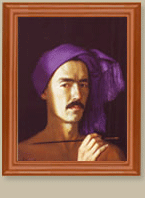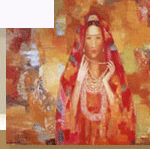





















The Art World of Akmal Ikramdjanov
The creative biography of Akmal Ikramdjanov takes its roots in the turn of 70s-80s when the pressure of declarative instructions lost its power all over the post-Soviet area, when liberalization in searching after new art ways came into life and at the same time grew the attention to individual self-expression and search for new aesthetic ideals.
Akmal graduated from the Institute of Painting, Sculpture and Architecture of I.E. Repin in Leningrad. His teachers were famous artists E. Moiseenko, A. Milnikov, V. Oreshnikov, A. Korolev and Uzbek masters of painting, A. Abdullaev, Ch. Ahmarov and R. Ahmedov, thanks to whom formed the stable academic basis, which specifies the creativity of the young artist from his first steps in art. His first works, "Still life", "Portrait of Student Kaumov", "Self-portrait", "Railwayman" and "Fires" expose deep knowledge of traditions of world realistic art school and their combining with national themes and colour.
His interest in a genre of portrait formed from the first steps. The artist gravitates less to external than to internal world of a person, which is being opened by means of different "speaking" details in the structure of composition. In the portraits he tends to expose a close affinity between a contemporary and traditions of ancient culture. The pictures "Self-portrait", "Echo of Centuries", "Photo-journalist N. Sharipov", "Surgeon K. Olimov", "Labour veteran I. Ikromov", "Chingiz Akhmarov", Khikmat Rahmonov" and "Picasso" manifest an idea that the past, presence and future are closely connected. In the portraits of the last ten years one feels the intention to bring to light the internal and external beauty of a person by means of colour and plastic expression of lines. In this way were created "Self-portrait", "Kamila", "The Ambassador of Turkey V. Chotuya", "The Ambassador of Japan Magasaki", "Portrait of Ulughbeg", "Khosiyat", portraits of daughters "Malika" and "Madina".
Nature is equally attractive for the artist. His interesl in this subject was revealed brightly after his visits to Surkhandarya in 80s when serious charges came in the artist's work: in his canvas music of colors obtained a new force, their magic bright colors became a characteristic feature of this cycle of works. He has found attractive poetry in nature, people, in their everyday life and environment. This resulted in the cycle of works dedicated to Surkhandarya. He keenly noted nature of this region, typical scenes of local file, what allowed creating of general characters having symbolic meaning. Such works are "The Surkhan valley", "Melody of the Earth", "Bodenkhan aya", "Rakhim bobo" and others.
Social themes were not also indifferent for him. Akmal, by means of imagery, could catch the life in various situations, relations between person and society. This is especially stressed in the pictures "Victim", "The Aral - my pain", "Tragedy of the Guissar" and "Eternal Perfection" where social theme is given not as ideological and market order but as the art principle - exposure of conflict between person and nature and ecological problems.
Unlike these above works the triptych "Melody of the Earth" transmits the optimistic notes exalting the beauty of earth and people living there; mild pastel shades dominate there reproducing a quiet melody.
The 80s with their complicated social context brought some innet tension in the artist's creativity transmitting a forefeeling of serious social changes The works of this cycle bears tending lo monumental subjects and means. The artist prefers majestic characters and fills up his canvas with philosophical thoughts. Such works are "The Might of Blue Birds", "Victim" and "Lightning". "Red Noose", which can be specified both as a genre canvas and a landscape, finalized that period. Strong social accent characterizes his triptych "Still life - 37" ("Life in Prison", "Conviction" and "Uncompleted Portrait") telling about victims of repression in 1937.
From 1940s a new stage began in the creative way of A. Ikramdjanov. These years, like previous ones, are full of searching for new themes, strengthening of allegoric and symbolic sounding and tending to monumental characters. The attempts of turn to the creative experience of the world culture are also notable, in particular, to surrealism. A good example in this context is his work "The Look" devoted to S. Dali.
The artist assimilated many now experiences in his Indian trip in 1990. This rich and multivarious culture, history, nature and people, legends and poems captured the artist's soul. He was interested in human relations, traditional concepts and modus related to such feelings as love and faithfulness, what was resulted in extremely beautiful canvas "Kama-sutra", gestalt in composition and colour. A source of all flesh and its symbol love are interpreted by means of true relations between man and woman.
The trip to India and meeting with culture ol the Baburids' epoch initiated a turn to own history and culture. This resulted in such works as "Kamaliddin Bekhzad", "Lovers", "Leili and Medjnun", "Alone Dervish" and "The day of angels", which proved that the artist found a new path in his creative way. In the pictures of this cycle lyric and romantic moods prevail. They attract our attention not only by their bright colour, inleresling structure of subject but their ability to make a spectator to fell to thinking of the historical themes.
Another aspect of A. Ikramdjanov creativity is connected with a genre of still life. The still lives of A. Ikramdjanov reflect his rich creative experience and his knowledge of the best achievements of "the Small Dutchs". Forming a composition and color, the artist as if gives them a life combining different things in integral organism. At the same time the still lives of A. Ikramdjanov expose the bright national character.
The works of A. Ikramdjanov cause warm feelings and high ideals in the human soul. The artist, by his creativity, proves that beauty is the revelation of national and panhuman aesthetic values. Akmal Ikramdjanov is among the brightest artists of Uzbekistan, who, following the academic principles of painting, creates canvas full of national color and sounding.
